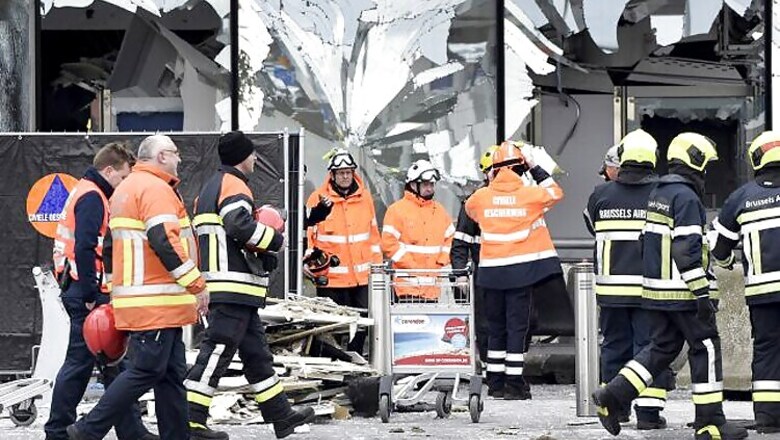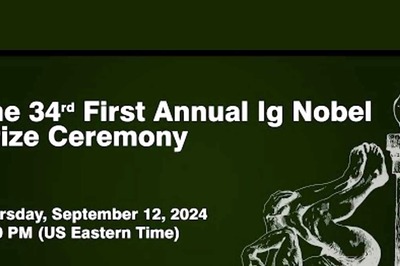
views
An empty apartment block on a quiet street turned out to be the perfect place for the three suspected Brussels attackers to prepare the home-made nail bombs used in Tuesday's airport and metro attacks that killed at least 31 people.
In a building undergoing renovation, there were no near neighbors to notice them taking in large quantities of strong-smelling household chemicals, as well as a suitcase of nails, to concoct an unstable white explosive powder known as TATP, or triacetone triperoxide, that they later used in their attacks.
"Even if someone had stopped them, they could have said the materials were for renovation," said Hassan Abid, an official at the local town hall, who was trying to determine why authorities had no knowledge of the men living illegally on the fifth floor.
Belgian investigators do not answer questions on the case.
Having moved in two months ago, the Belgian brothers Khalid and Brahim El Bakraoui used the apartment in the largely middle class borough of Schaerbeek as a laboratory-cum-hideout, from where Brahim and two other men took a taxi on Tuesday morning to the airport to commit their attacks.
Their choice of low-cost explosives -- among ingredients are drain cleaner and nail varnish remover -- apparent knowledge of chemistry and ability to set up in an apartment 15 minutes drive from the airport should offer clues about IS bombmaking methods to investigators struggling to understand how the Syria-based group built a violent network of radicalized young Belgians.
The ready availability of ingredients, compared to military explosives favored by older militant groups like the IRA in Northern Ireland or Basque separatists ETA in Spain, highlights the risks across Europe of more big attacks.
However, the need for premises to manufacture quantities of TATP over several weeks and the final mixture's "use by" date of just a few days make the bombmakers vulnerable to the intensive search efforts of detectives on their trail. French and Belgian police have successfully found and neutralized bomb "factories", most recently in the Paris suburb of Argenteuil on Thursday.
Terrorists have used fake identities and premises listed with municipal authorities as unoccupied to evade residency checks.
Brussels police failed to find the Schaerbeek flat in time, but were there shortly after the attacks, aided by the taxi driver who unwittingly took the three men to the airport.
Prosecutors uncovered 15 kg (33 lb) of TATP, as well as 180 liters of the chemicals needed to make bombs.
"Mother of satan"
TATP is a highly volatile explosive. Palestinian insurgents who experimented with it in the 1980s nicknamed it "the mother of Satan" because the white crystal powder can be easily detonated by a cigarette, a match or too much heat.
It also loses its potency over time as the chemicals decay.
Used in the 2005 London bombings and the Nov. 13 Paris attacks, and found in a series of foiled bomb attempts in Europe since 2007, TATP appears to be Islamic State's explosive of choice.
However, unlike the smuggled firearms also used in the Paris attacks that killed 130 people, TATP offers no easy trail for European intelligence agents to track because purchasing the ingredients is easily done at any local hardware store or pharmacy and rarely attracts attention.
Making a TATP bomb, although a more lengthy process than the fertilizer-based explosives used by other European militants, is cheap and simple and recipes and videos by chemistry buffs abound on the Internet. It was discovered by a 19th century German chemist and is very powerful, even in small quantities.
All the ingredients - acetone found in cleaning products, hydrogen peroxide found in wood bleach and sulphuric acid used to unblock kitchen pipes - were available at one Brussels hardware store this week for less than 40 euros ($45).
Nails and bolts can be added to increase the bomb's impact and afterwards stuffed into bags and taped into suicide belts.
It goes undetected by airport scanners, leaving authorities to rely on sniffer dogs. Though the bombs can have a strong smell -- the bombers' taxi driver said he smelled chemicals on the ride to the airport -- there were few such dogs in the Brussels' airport check-in area on Tuesday when the men detonated the explosives hidden in holdalls on baggage trolleys, according to several witnesses, including an airport worker.
Chemistry student
Ehud Keinan, an Israeli scientist who has spent 35 years studying TATP, said that as little as 4 kg could produce the kind of devastation seen in Brussels.
"It is very easy to make, not like a conventional bomb," said Keinan, the dean of chemistry at Technion-Israel Institute of Technology in Haifa. "You don't need to be part of a large organization or need training to do this."
Still, one of the three Brussels suspects, Najim Laachraoui, a 25-year-old Belgian who blew himself up in the airport attack and is suspected of making suicide vests for Paris, had studied engineering at university and excelled in lab work.
Islamic State is also making TATP on an industrial scale in Syria and Iraq, according to a report last month by EU-funded Conflict Armament Research.
The emergence of Kalashnikov assault rifles as a weapon of choice for Islamic State in Europe in the past two years, notably in Paris, has led to EU efforts to crack down on weapons traffickers.
But disrupting TATP supplies is harder.
The European Union in 2014 passed new legislation for all the bloc's 28 countries to restrict the marketing and use of chemicals that could be used to make explosives, and in some cases requires identity checks on those purchasing them.
Within two weeks of the July 2005 London attacks, the British chemical industry and British hardware stores stepped up their reporting of suspicious or large purchases of chemicals.
However, in France, the explosive precursor hydrogen peroxide is sold legally as a way to clean private swimming pool water and no one is considering banning nail varnish remover.
"If you go into any pharmacy in Brussels, you can buy 50 ml of acetone. If you go into a hundred pharmacies, you can get that much more," said Peter Newport, the chief executive of Britain's Chemical Business Association, which sits on the European Commission's expert group on regulating precursors.
"There are so many valid uses by the public of these substances."

















Comments
0 comment